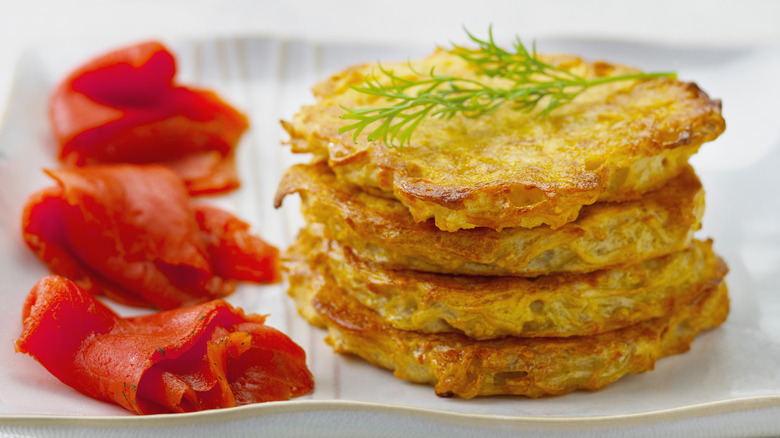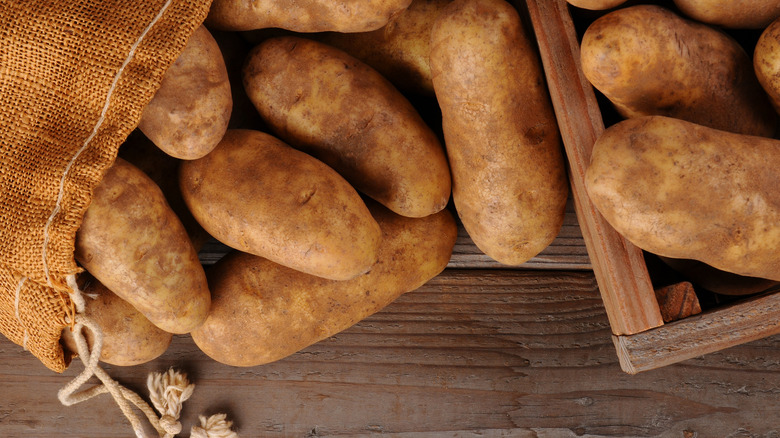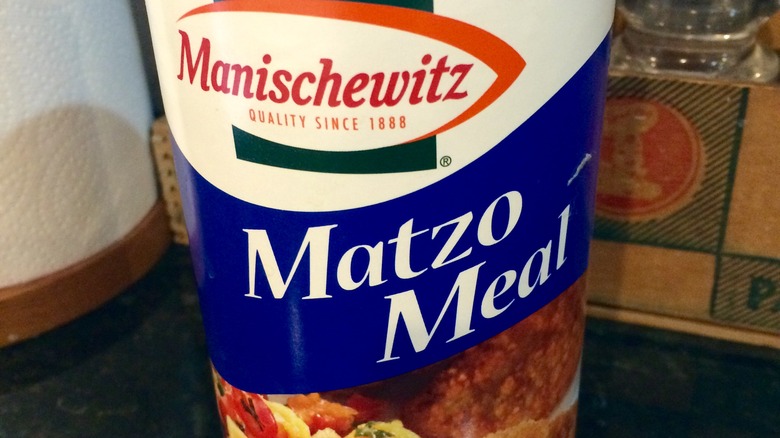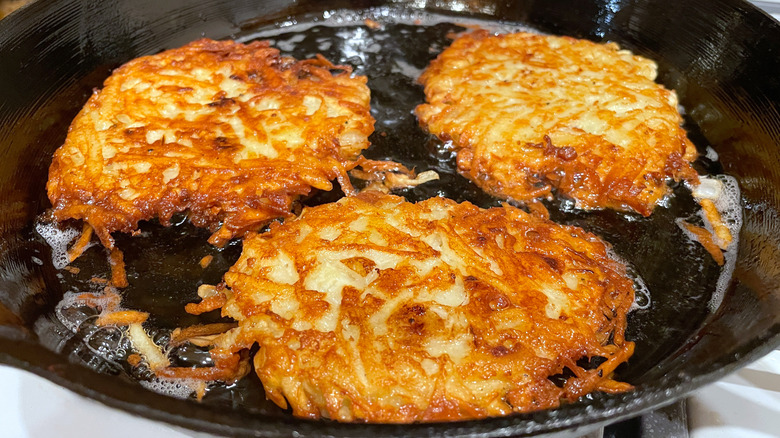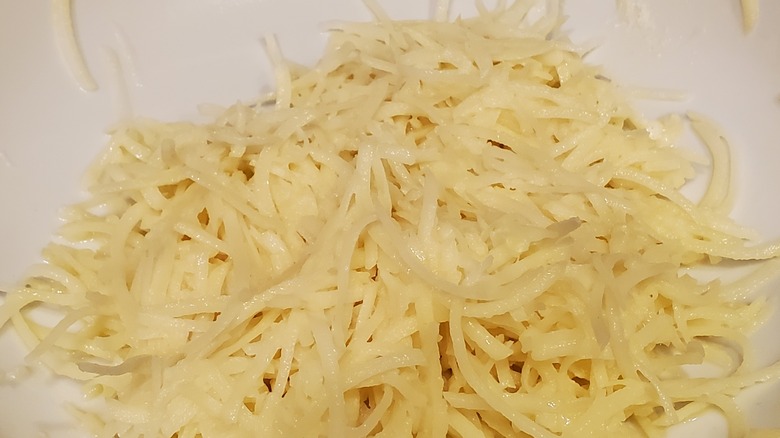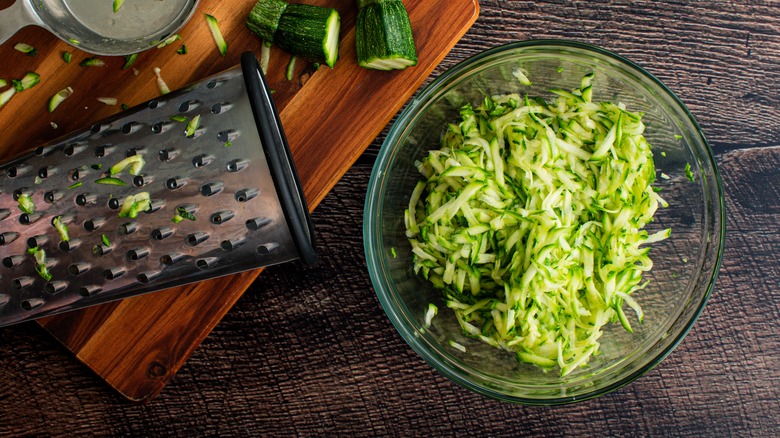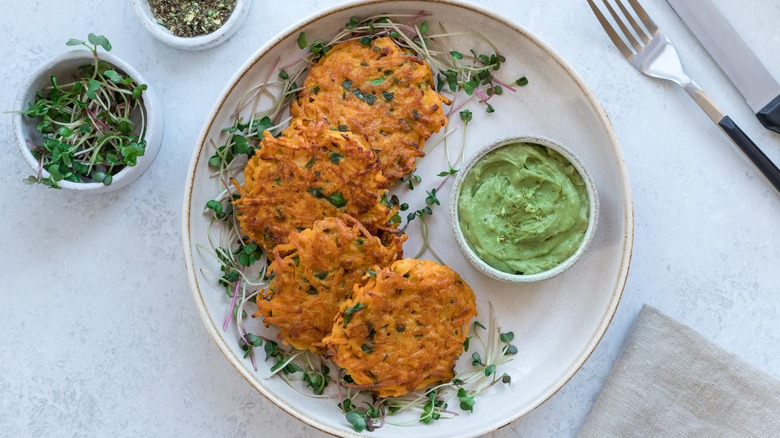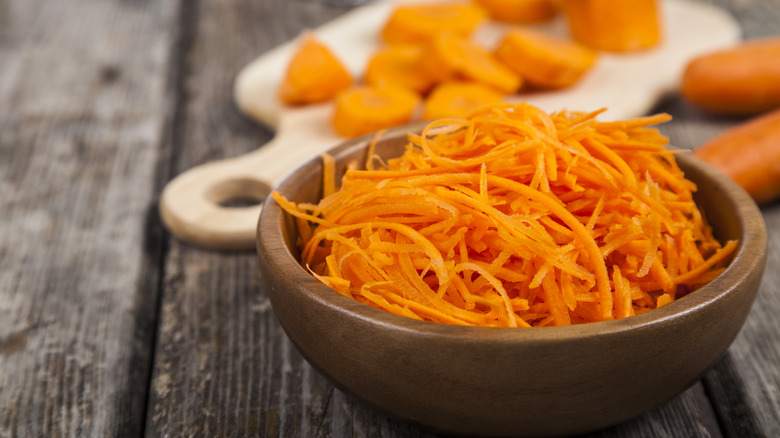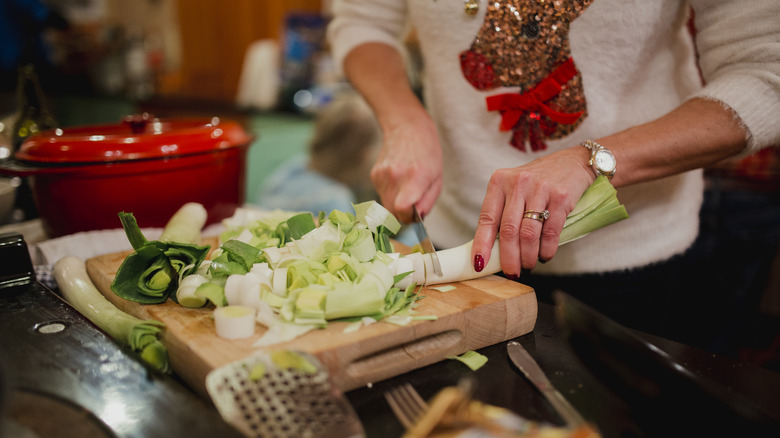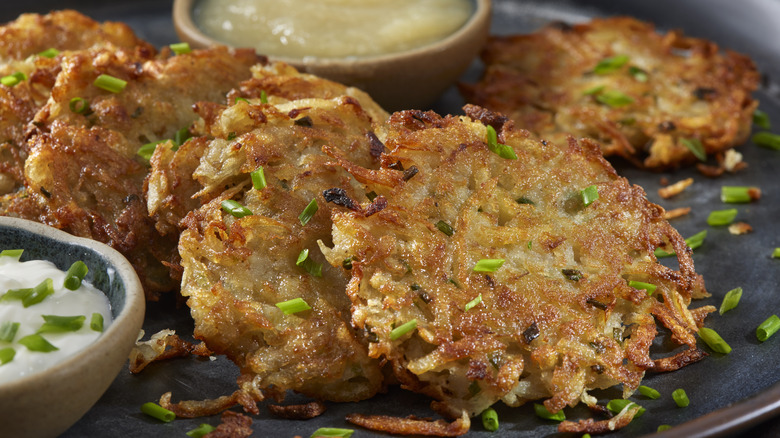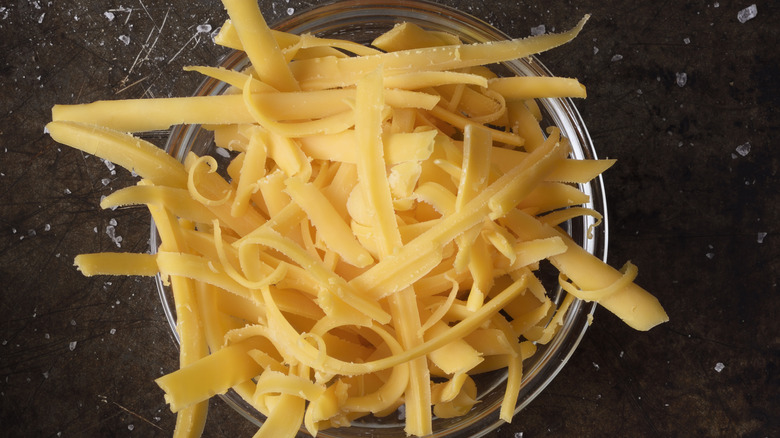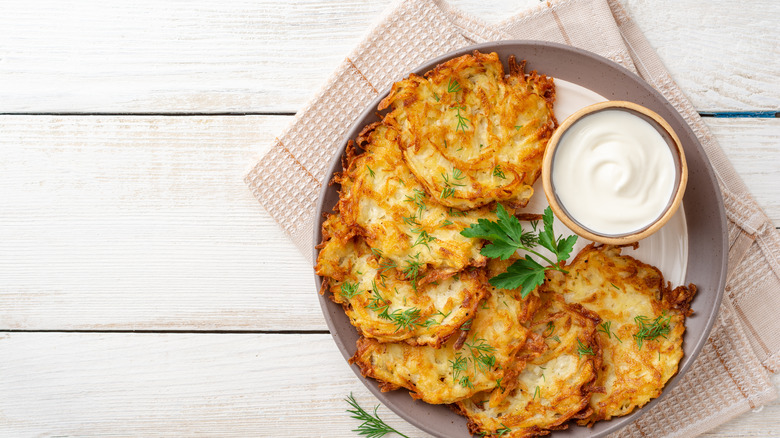Secret Ingredients To Elevate Your Latkes
The latke is a deceptively simple thing to make. This traditional potato pancake is a dish that comes out a lot during Thanksgiving and the holidays in Jewish households. While they can include various ingredients, with delicious results, they mostly contain just shredded potatoes and onions. However, making them perfectly is no easy feat — it's one that takes generations to master. They're pan-fried in oil, and the result is crispy, sometimes fluffy on the inside, sometimes not, and always delicious. Make sure to salt generously and you'll have one of the best potato dishes on Earth.
We first wanted to highlight the best ingredients to include when making latkes. There are common mistakes when it comes to which binders and oils to use that need to be nipped in the bud before you start to make any variations. We've also offered up plenty of good alternatives for regular ingredients, like swapping out potatoes with sweet potatoes. These fun substitutions will help you flex your creativity, but regardless of whether you want high quality or a new twist on an old holiday favorite, this list has you covered on elevating your latkes this holiday season.
Russet potatoes
There is no definitive right way to make latkes, but there are a few wrong ways. One of the biggest of those wrong ways is to use the wrong kind of potato, and this can easily be a fatal flaw in latke making. To start with, there is one type of potato you should be using to make your latkes and it just happens to be the most commonly preferred type of potato in the U.S. That's right, stick to russet potatoes when making your latkes.
This is not exactly a secret per se, but it's worth pointing out the main reason why russets are the best spud for the job, while more waxy types of potato are best avoided. It's their high starch content that makes russets the best option. They consistently make the best latkes that don't fall apart, even without any flour to bind them together.
Matzo meal
Latkes need a binder in order for all the elements to stick together. One of these binders is egg, but often you see that in conjunction with breadcrumbs to help the pancake cohere. What you might not know is that matzo (or matzah) meal is the best binder there is.
Naturally, you'll need to use at least one egg too, if not two or more depending on how many latkes you're planning to make. You can add in breadcrumbs or flour as well, but matzo meal is a more traditional and tasty way to bind everything together. If you have regular matzo on hand, you can also crumble it up to make the equivalent of matzo meal for your latkes.
Latkes need this added starch to hold together beyond just the egg mixture. As we'll get into, there are other secret ingredients you can use to ensure your latkes all come out uniform and in one piece — although we can't complain about the fried crumbs of potato that always come off when cooking them up. Those are delicious!
Canola oil
When it comes to frying, there are a number of oils you can use for different results. Frying latkes generally conforms to the number one rule of deep frying — use a neutral oil. This means avoiding highly flavorful oils, particularly olive oil which has a strong scent and distinct taste.
According to Jewish chefs, canola oil is one of the best choices for frying latkes due to its neutral flavor and high smoke point. This means that you can cook with the oil for a long time at a high temperature and it won't burn. In turn, the hot oil will allow your latkes to get perfectly crisp on the outside while maintaining a fluffy internal texture. Regular vegetable oil and peanut oil are also acceptable alternatives to provide these qualities. These are fine options if you have them on hand but, given the choice, many Jewish chefs and their families for generations before them prefer canola oil above anything else.
Potato starch
This is an optional trick that can elevate your latkes if you're looking to impress this holiday season. When you are preparing your potatoes for latkes you need to wring them out. Traditional recipes call for raw potatoes, though you can consider par-cooking them before shredding — a trick used by chef Joan Nathan to get perfect latkes.
After shredding your potatoes, take them in a cheesecloth (or paper towel) and squeeze out all the water. Without this crucial step, the potatoes will contain too much liquid and the consistency of your latkes will be all wrong. However, when you are wringing out your potatoes, you can preserve the liquid that comes out and add it back in later for an extra hit of starch.
Preserving the potato starch is an age-old technique. According to professional chef Leah Koenig, potato starch is the secret ingredient that imbues the latkes with a crisper texture and even more potato flavor. She suggests you first give the liquid time to sit, to separate out the heavy starch that falls to the bottom, and then use that starch as a binder. Adding the starch back in before you form your latkes will elevate them from great to out of this world.
Zucchini
When it comes to making big changes to your latkes, you can't just swap in vegetables willy-nilly. With that said, there's a surprising amount of them that can make the tested and approved list, and that goes beyond just root vegetables. Look to zucchini, the above-ground beauty, to see how you can make a healthier take on this traditional holiday potato dish.
Leah Koenig says that you should play around with which ingredients you use for latkes and one of her first recommendations was zucchini. The Jerusalem Post also lists zucchini as a good alternative to potatoes if you're looking to make healthier latkes. It's notably an easy vegetable to grate, that can also make for a flavorful base. Since grating both your potatoes and onions and making your mixture uniform is such an important part of the latke process, any substitute must break down well when taken to the grater. Beets and sweet potatoes are other examples of veggies you can grate for latkes and other similar fried dishes.
Sweet potatoes
If you want to try something a little different, but still on-theme for the holidays, sweet potato latkes are the way to go. A big hit at Thanksgiving, these latkes are an addictive blend of sweet and savory that we just can't get enough of. You can simply use your traditional latke recipe and substitute in sweet potatoes for a pretty astounding result. Despite the differences in texture, you still need to shred and wring the liquid out of your shredded vegetables before mixing in the binders and forming your latkes. Or you can follow a more tailored recipe with extra ingredients to complement the sweet potatoes, for a more upscale result.
In terms of health benefits, there are plenty of reasons to eat sweet potatoes instead of regular russets. Sweet potatoes contain high levels of beta-carotene and vitamin A. They contain roughly the same amount of carbs as regular potatoes, but have more fiber and a lower glycemic index, making sweet potatoes a healthier option.
Carrots
Carrots are another healthy alternative to potatoes that can be mixed with various other vegetables to create sweet and savory varieties of latkes. Carrots are rich in beta-carotene and antioxidants, and provide a good source of fiber and other nutrients such as vitamin A and potassium. Carrots are a great vegetable that, frankly, most adults probably don't eat enough of. So, with that being said, how exactly can you turn carrots into a delicious fried side to serve at your next family meal?
Carrots are just as easy to shred as potatoes, if not easier. However, they aren't quite substantive enough to make an entire latke by themselves. Fortunately, you have plenty of flavors to choose from when it comes to what you choose to mix in, whether you're using shredded meat like Leah Koenig suggests, or veggies. Mix carrot with zucchini and beets for a veggie fritter, or with raisins and nuts for something a bit sweeter. Either way, it's getting fried until golden brown and delicious.
Leeks
Leeks are an uncommon substitute for onions, but in this context they actually work quite well. These giant stalky vegetables are aromatic, with a flavor similar to onion but with a sweeter and more licoricey tinge to them. When the purpose is making latkes, leeks can be substituted for onions to make a potato pancake with a little more subtle sweetness and depth.
Leeks have a flavor profile that can also go with other vegetables like kale, or with savory ingredients like cheddar cheese. However, at its most basic, a leek can still make a radical change to your latke's flavor. Israeli chef and cookbook author Michael Solomonov has many recipes for latkes. One of them, from his cookbook "Israeli Soul," includes just leeks and russet potatoes as well as a tiny bit of flour for binding. These potato leek latkes prove that when it comes to traditional dishes like this, sometimes simplicity is best.
Scallions and chives
In terms of substituting or adding onions to your latkes, you can try adding green onions. Also known as scallions, these are found frequently in Asian cuisine, but are also very commonly used in Western cooking and can be found easily in American supermarkets. Using scallions instead of, or in addition to, regular white onions will result in a different flavor. This variation on the traditional dish has gone on to become a staple at places like the California-based Linda's Gourmet Latkes. This family-owned company has been operating since 2004 and currently sells a green onion flavor that was featured on Oprah Magazine's 2014 Holiday O List of best products.
Sour cream and chives are an accompaniment commonly found with latkes, but this onion-like herb can also be incorporated into your recipe. Chives can work in a similar fashion to scallions, either as a garnish or an ingredient in your latke recipe, and they go just as well with sweet potatoes as they do with regular ones.
Cheese
It might seem like we're straying far afield from traditional preparation at this point, but this ingredient actually goes way back to the origin of the dish; the Italian ricotta pancake is an early ancestor to the latke. Potato latkes were an Ashkenazi invention from Poland and Ukraine once potatoes became a popular crop in the 1800s. Before this, though, cheese latkes may have just been the go-to.
These days, if you want potatoes and cheese, latkes aren't usually what comes to mind first, but there are a couple of tasty directions you can go with this one. Chef Michael Solomonov, featured on the Rachel Ray show, recommends sharp Cheddar in your latkes to pair with horseradish on the side. The rich flavor of Cheddar cheese gives a taste that goes excellently with potatoes so this recipe is a no-brainer.
Feta is also a great accompaniment or mix-in to your latke recipe, especially if you are making them with one of the suggested veggies above (or a mix of them). Feta goes well with zucchini, spinach, or any other green vegetable you want to throw in the food processor.
Dill
Dill is another herb that you may have lying around the kitchen. Don't let that freshness go to waste. Instead, try incorporating your dill into your latke recipe this holiday season.
Pantry seasonings like garlic powder and onion powder are commonly added to give potato dishes, including latkes, an extra kick of flavor. Dill, however, is a bit less commonly found in holiday dishes like mashed potatoes and potato pancakes. All the same, this herb can elevate your latkes to a whole new level with its hints of citrus and anise. Chef Hadar Cohen Aviram says that dill, in conjunction with other herbs like dried basil and parsley can add some delicious flavor to your latkes.
Dill is another flavor that goes well with sour cream. Since you already likely have sour cream on hand, Aviram suggests that adding a little bit to your dill latke recipe can do wonders for the texture, turning the inside into something decadent and luxurious.
